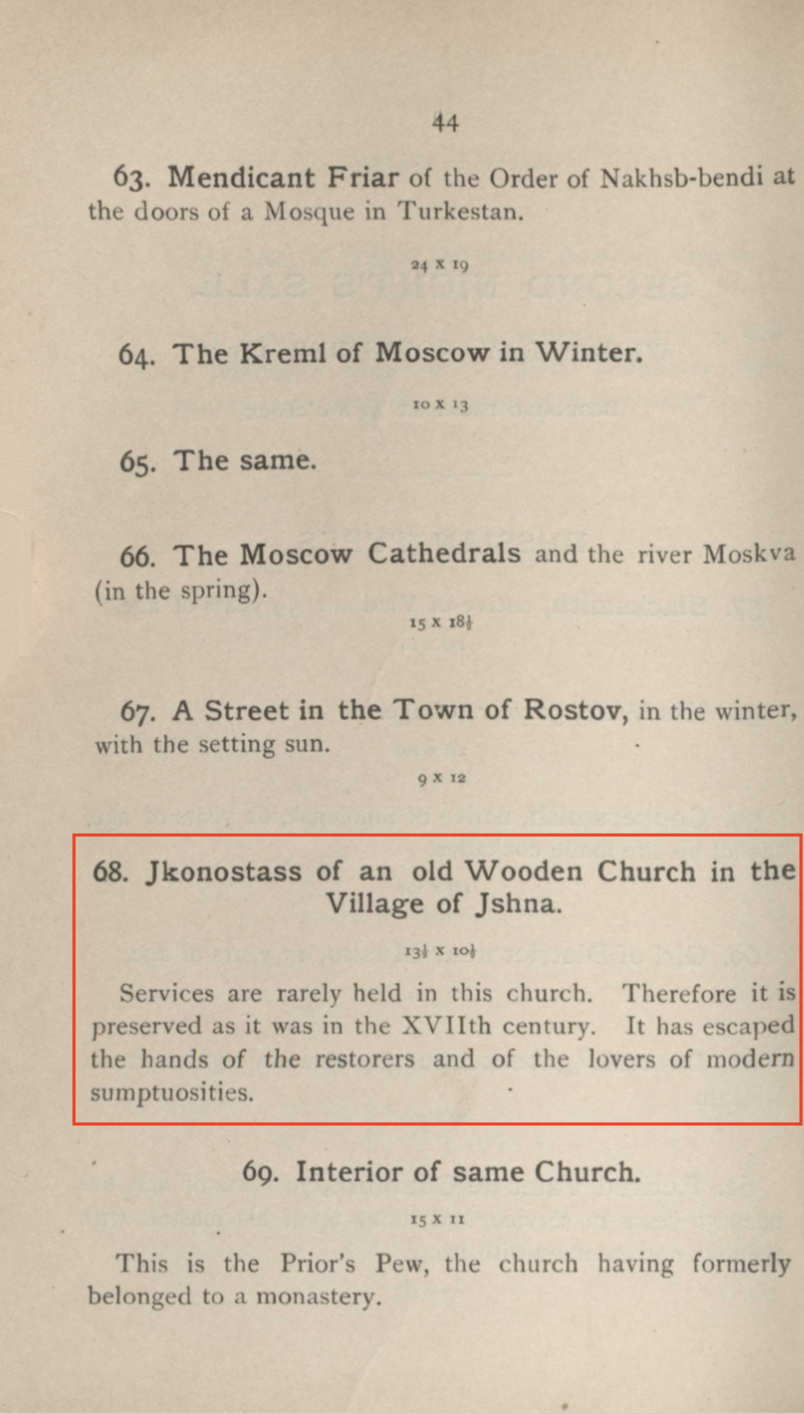Important European Collection of Russian Art, plus Other Properties
30 May 2020

* 15. VERESCHAGIN, VASILY VASILIEVICH (1842–1904)
Iconostasis of the Church of St John the Evangelist on the Ishnya River near Rostov Yaroslavsky .
Oil on canvas, 34.5 by 27 cm.
25,000–40,000 GBP
Provenance: Vassili Verestchagin Collection, American Art Galleries, New York, 17–18 November 1891, lot 68.
Acquired at the above sale by an oil tycoon Silas H. Paine, USA.
Private collection, USA.
A gift from the above to the present owner c. 2000.
Private collection, USA.
Exhibited: L'exposition des œuvres Nouvelles de Vassili Vereschagin, Cercle artistique et littéraire, Paris, April 1888.
Exhibition of the Works of Vassili Verestchagin, itinerant: New York (American Art Galleries), Chicago (Chicago Art Institute), Philadelphia (The Pennsylvania Academy of Fine Arts), St Louis, Baltimore, Boston, etc, 1888–1889, No. 100.
Vassili Verestchagin Collection, American Art Galleries, New York, November 1891, No. 68 (stamp on the reverse and label on the stretcher).
Literature: Possibly, V. Stasov, “Vystavka Vereschagina v Parizhe”, Novosti i birzhevaia gazeta, No. 121, 3 May, 1888, p. 2, mentioned in the text.
Exhibition catalogue, Exhibition of the Works of Vassili Verestchagin, Illustrated Descriptive Catalogue, New York, American Art Galleries, 1888, p. 64, No. 100, listed.
Vassili Verestchagin Collection, Illustrated Descriptive Catalogue, New York, American Art Association, 1891, p. 44, No. 68, listed.
“The Verestchagin Sale: Livelier Bidding on the Second Evening – The Prices Realized”, The New York Times, 19 November 1891, p. 5, listed.
F. Bulgakov, V. V. Vereschagin i ego proizvedeniia, St Petersburg, Tipografiia A. S. Suvorina, 1896, p. 75, listed.
Vassili Verestchagin Collection, Nordestedt, Hanse, reprint of: New York, American Art Association, 1891, p. 44, No. 68, listed.
Iconostasis of the Church of St John the Evangelist on the Ishnya River near Rostov Yaroslavsky is, perhaps, the most spectacular of the paintings of the interior of the ancient wooden church that Vereschagin produced during his stay in Rostov the Great in the winter of 1887-1888. The artist created three versions of the interior, two of which now adorn the collection of the State Russian Museum, while the third is now presented for auction at MacDougall’s.
When preparing for a landmark exhibition in Paris that was extremely important to him, the artist set off on a journey to Rostov and its environs late in 1887 in search of images for a series of works about Russia. Day after day, Vereschagin travelled to the small village of Bogoslov, a mile or so to the southwest of the town, where he worked keenly on views of the wooden church of St John the Evangelist, which he found particularly enticing. The old, austere interior of the church, built in 1687, impressed the artist far more than the building’s outward appearance. Vereschagin was especially attracted by the four-tiered iconostasis with its ornamentation, time-darkened icons and carved, gilded Royal Doors, the work of the 16th-century Rostov woodcarver and monk Isaia. Depicted from different angles on two of the three canvasses that Vereschagin painted in the church, the iconostasis creates a picturesque image of Russian antiquity, in which the skilfully constructed composition and the subdued radiance of the chandelier and icon oklady generate a literally physical sense of time, frozen in the gloom of the church’s interior.
The artist left Rostov in February 1888, and the works he created there managed to reach Paris in March to appear at his solo exhibition, which opened on 1st April at the Artistic and Literary Circle (Cercle artistique et littéraire). Vereschagin’s exhibition was such a resounding success that the French press acclaim even reached Russia. In particular, Stasov drew up a survey of fifty Parisian reviews, in which he cited a comment by a writer in Le Parisien who was excited inter alia by the “priceless iconostasis” and “the inside” of the Church of St John the Evangelist on the Ishnya.
Vereschagin’s exhibition was expanded when it moved from Paris to New York, where its fame proved to be even greater than in France. Its subsequent triumphal progress through the United States ended back in New York in November 1891 with a grand auction both of the artist’s works and of items from his collection of antiquities and folk art.
The painting Iconostasis of the Church of St John the Evangelist on the Ishnya River near Rostov Yaroslavsky was acquired by the American oil tycoon Silas Paine, a director of Standard Oil, which was at that time a monopoly in the US oil industry. It may have been the religious subject that prompted Silas Paine, an ardent Christian, to purchase the picture, which was owned by him for a long time and is now to be auctioned.
The present lot as listed in the 1891 publication.


Notes on symbols:
* Indicates 5% Import Duty Charge applies.
Ω Indicates 20% Import Duty Charge applies.
§ Indicates Artist's Resale Right applies.
† Indicates Standard VAT scheme applies, and the rate of 20% VAT will be charged on both hammer price and premium.